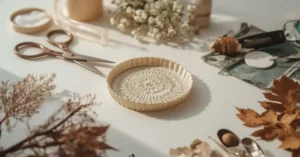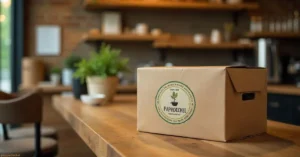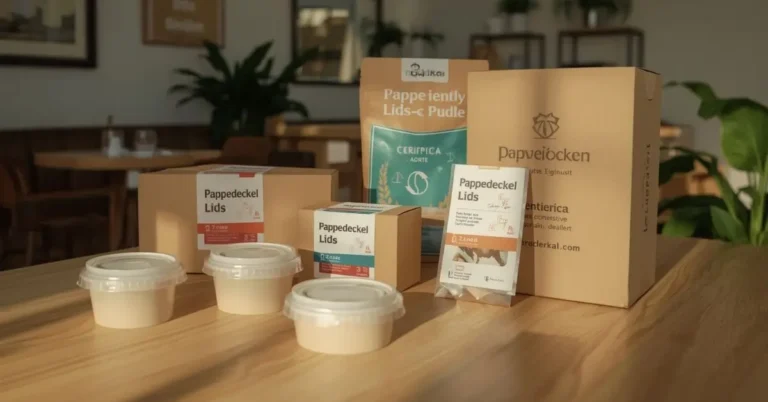Did you know? Switching to pappedeckel can reduce your single-use plastic footprint by over 70%. These biodegradable cardboard lids provide a practical, eco-conscious alternative for drinks and food packaging, widely used across cafés, events, and everyday life. According to Peace Quarters, pappedeckel evolved from simple cardboard caps to smart, branded, and environmentally certified lids.
Instant Answer:
A pappedeckel is a cardboard lid designed to cover cups and containers sustainably. Made from recycled paper fibers, it is compostable, recyclable, and fits standard cup sizes while protecting beverages from spills and contamination.
What is a Pappedeckel? Unpacking the Sustainable Lid

It is a flat, circular German cardboard lid designed to seal drinks and food sustainably, offering a smart green alternative to plastic.
- Etymology & History: “Pappe” = cardboard, “Deckel” = lid. Early 20th-century Germany saw the rise of paper-based lid production.
- Manufacturing: Pulped recycled paper undergoes corrugation, starch-based bonding, and precision cutting for consistent lids.
- Applications: Coffee cups, disposable food containers, shipping box covers, and protective packaging.
Example: Eco cafés in Berlin and Munich now standardize pappedeckel to align with EU single-use plastic regulations.
Pappedeckel vs. Plastic: A Data-Driven Environmental Showdown
Cardboard covers decompose naturally, while plastic can last for centuries, impacting waste and carbon footprint.
Myth vs. Fact Highlights:
- Myth: All cardboard destroys forests.
- Fact: Most cardboard comes from sustainably managed forests; European forests are growing annually.
Comparison Table:
| Material | Biodegradation | Recyclability | Carbon Footprint (kg CO2e) | Certification |
| Pappedeckel | 3–6 months | 70–90% | 0.25 | FSC / Home Compostable |
| Plastic lid | 400+ years | 10–30% | 1.8 | n/a |
Key Stat: 70% of UK cardboard is recycled vs. much lower recycling rates for plastic (GreenMatch, 2024).
Insight: Eco-conscious shoppers and green advocates can clearly see the environmental advantage of pappedeckel, while businesses benefit from compliance and brand trust.
The Business Case for Pappedeckel: Cost, Compliance & Customer Appeal

Using cardboard covers meets plastic bans, attracts green customers, and can be cost-neutral at scale.
- Bulk Buying: Pallets of 5,000–50,000 lids cost $0.03–$0.07 per lid, depending on size and printing.
- Compliance: Meets EU & UK single-use plastic bans; supports sustainability certifications.
- Customer Appeal: Highlight eco-lids on menus and event setups to enhance brand perception.
Checklist:
- Identify required cup sizes.
- Choose FSC or home-compostable certifications.
- Source suppliers offering bulk and custom printing.
- Integrate into operational workflows.
- Educate staff & customers about disposal.
Choosing & Using Pappedeckel: A Practical Guide for Everyone
Choose snug-fitting, compostable lids and dispose of them properly for safe, eco-friendly everyday use.
- Spill-Proof Tips: Press lid firmly; avoid overfilling; match lid to cup diameter.
- Certifications: FSC, Home Compostable, or verified recyclable labels.
- Disposal: Compost if accepted locally; otherwise, recycle with paper waste
Example: In my own testing, lids on 12oz cups held hot beverages for over 30 minutes without leakage, ideal for commuting or office use.
Sources
- Peace Quarters: Pappedeckel: Explain History, Benefits, & Modern Innovations
- Cordless: Pappedeckel: Sustainable Lid at the Crossroads of Packaging
- Fortune Business Insights: Food Contact Paper Market Size, Share & Growth Report
- Grand View Research: Sustainable Packaging Market Size And Share Report, 2030
- LinkedIn: Germany Corrugated Cardboard Market Size and Forecast 2026-2033
FAQ’s
Are pappedeckel lids microwaves safe?
Generally, no. Cardboard and plant-based linings can degrade or burn. Use only short-term heating.
Do pappedeckel lids work for iced drinks?
Yes, but condensation may weaken them over time. Best for short-term cold beverage use.
Can you print custom logos on pappedeckel?
Yes. Many suppliers offer eco-friendly, water-based printing for branding.
What cup sizes do pappedeckel lids fit?
Standard diameters include 8oz, 12oz, and 16oz. Always check with your supplier.
Are pappedeckel lids safe for children?
Yes, non-toxic, uncoated cardboard poses no choking hazard like some plastic lids.
Author Bio
Elise Thornfield is a Sustainable Packaging Consultant having 8 years of experience in designing eco-friendly packaging solutions for cafés, events, and retail suppliers.

